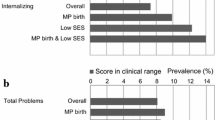Summary
In a prospective longitudinal study starting at birth 384 infants and their families were investigated. The subjects were distributed across the nine cells of a two-factorial design (3 × 3), factor 1 representing the degree of organic, factor 2 the degree of psychosocial risk. At age 3 months there was a significant influence of organic risk factors on all developmental parameters. Psychosocial risks were only relevant for cognitive development and behaviour problems. Organic high-risk children who adapted quickly after birth showed an especially good development status.
Similar content being viewed by others
References
Bayley N (1969) Bayley Scales of Infant Development. The Psychological Corporation, New York
Birch H, Gussow CD (1970) Disadvantaged children. Grune and Stratton, New York
Blanz B, Esser G, Schmidt MH (1987) Präventive Möglichkeiten bei psychischen Störungen von Eltern und Kindern. In: Laaser U, Sassen G, Murza G, Sabo P (eds) Prävention und Gesunditserziehung. Springer, Berin Heidelberg New York, pp 85–90
Cohen SE, Sigman MM, Parmelee AH, Beckwith L (1982) Perinatal risk factors in preterm infants. Appl Res Ment Retard 3:776–776
Crnic K, Ragozin AS, Greenberg MT, Robinson NM, Basham RB (1983a) Social interaction and developmental competence of preterm, and fullterm infants during the first year of live. Child Dev 54:1199–1210
Crnic KA, Greenberg MT, Ragozin AS, Robinson NM, Basham RB (1983b) Effects of stress and social support on mothers of preterm and full-term infants. Child Dev 54:209–217
Esser G, Schmidt MH (1987) Minimale cerebrale Dysfunktion — Leerformel oder Syndrom? Enke, Stuttgart
Esser G, Scheven A, Petrova A, Laucht M, Schmidt MH (1989) Mannheimer Beurteilungsskala zur Erfasssung der Mutter-Kind-Interaktion im Säuglingsalter (MBS-MKI-S) Z Kinder-Jugendpsychiatr 17:185–193
Field TM (ed) (1980) High risk infants and children. Academic Press, New York
Field TM (1983) Early interactions and interaction teaching of high-risk infants and parents. In: Perlmutter M (ed) Development and policy concerning children with special needs. Minn Symp Child Psychol 16:1–33
Fischer WM (1976) Cardiotokographie. Thieme, Stuttgart
Flehmig J (1983) Normale Entwicklung des Säuglings und ihre Abweichungen — Früherkennung und Frühbehandlung. Thieme, Stuttgart
Greenberg MT, Crnic KA (1988) Longitudinal predictors of developmental status and social interaction in premature and full-term infants at age two. Child Dev 59:534–570
Hadders-Algra M, Huisjes JH, Touwen BCL (1988a) Perinatal correlates of major and minor neurological dysfunction at school age: a multivariate analysis. Dev Med Child Neurol 30:472–481
Hadders-Algra M, Huisjes HJ, Touwen BCL (1988b) Perinatal risk factors and minor neurological dysfunction: Significance for behaviour and school achievement at nine years. Dev Med Child Neurol 30:482–491
Hunt JV (1981) Predicting intellectual disorders in childhood for preterm infants with birth weights below 1500g. In: Friedman LS, Sigman M (eds) Preterm birth and psychological development. Academic Press, New York
McDonald AD (1964) Intelligence in children of very low birth weight. Br J Prevent Soc Med 18:59–74
Meyer-Probst B, Teichmann H (1984) Risiken für die Persönlichkeitsentwicklung im Kindesalter. Thieme, Leipzig
Pasamanick B, Knobloch H (1966) Retrospective studies on epidemiology of reproductive causality: old and new. Merril-Palmer Q 12:7–26
Prechtl HFR (1968) Neurological findings in newborn infants after pre- and paranatal complications. In: Jonxis JHP, Visser HKA, Troelstra JA (eds) Aspects of prematurity and dysmaturity. Steufert Kroese, Leiden
Prechtl HFR, Beintema DH (1976) Die neurologische Untersuchung des reifen Neugeborenen. Thieme, Stuttgart
Rauh H (1984) Frühgeborene Kinder. In: Steinhausen HC (ed) Risikokinder. Kohlhammer, Stuttgart
Rauh VA, Achenbach TM, Nurcombe B, Howell CT, Teti DM (1988) Minimizing the adverse of low birth weight: four-year result of an early intervention program. Child Dev 59:544–553
Rubin RA, Balow B (1979) Measures of infant development and socioeconomic status as predictors of later intelligence and school achievement. Dev Psychol 15:225–227
Rutter M (1971) Parent-child separation: psychological effects on the children. J Child Psychol Psychiatry 12:233–260
Rutter M (1979) Maternal deprivation, 1971–1978: new findings, new concepts, new approaches. Child Dev 50:283–305
Rutter M, Quinton D (1977) Psychiatric disorder — ecological factors and concepts of causation. In: McGurk M (ed) Ecological factors in human development. North Holland, Amsterdam
Sameroff A (1979) The etiology of cognitive competence: a systems perspective. In: Kearsley R, Siegel J (eds) Infants at risk: assessment of cognitive functioning. Wiley, New York, pp 37–54
Sameroff A, Chandler M (1976) Reproductive risk and the continuum of car-taking causality. In: Horowitz FH (ed) Review of child development research, vol 4. University of Chicago Press, Chicago
Siegel LS (1983a) Correction for prematurity and its consequences for the assessment of the very low birth weight infant. Child Dev 54:1176–1188
Siegel LS (1983b) Reproductive, perinatal and environmental factors as predictors of the cognitive and language development of preterm and fullterm infants. Child Dev 54:963–973
Smith L, Smorvik D, Sommer FF, Tetzchner S (1982) A longitudinal study of low birth weight children. Semin Perinatol 6:294–304
Thomas A, Chess A, Birch HG (1968) Temperament and behaviour disorders in children. University Press, New York
Touwen B (1976) Neurological development in infancy. Clin Dev Med 58:1–150
Vojta V (1984) Die zerebralen Bewegungsstörungen im Säuglingsalter — Frühdiagnose und Frühtherapie. Enke, Stuttgart
Voll R, Allehoff WH, Esser G, Poustka F, Schmidt MH (1982) Widrige familiäre und soziale Bedingungen und psychiatrische Auffälligkeit bei Achtjährigen. Z Kinder- Jugendpsychiatr 10:100–109
Werner EE, Biermann JM, French FE (1971) The children of Kauai. University of Hawaii Press, Honolulu
Author information
Authors and Affiliations
Additional information
This research was supported by the Deutsche Forschungsgemeinschaft as a part of the Sonderforschungsbereich 258 “Risikomodelle psychischer Störungen”
Rights and permissions
About this article
Cite this article
Esser, G., Laucht, M., Schmidt, M. et al. Behaviour problems and developmental status of 3-month-old infants in relation to organic and psychosocial risks. Eur Arch Psychiatr Neurol Sci 239, 384–390 (1990). https://doi.org/10.1007/BF01734547
Received:
Issue Date:
DOI: https://doi.org/10.1007/BF01734547




